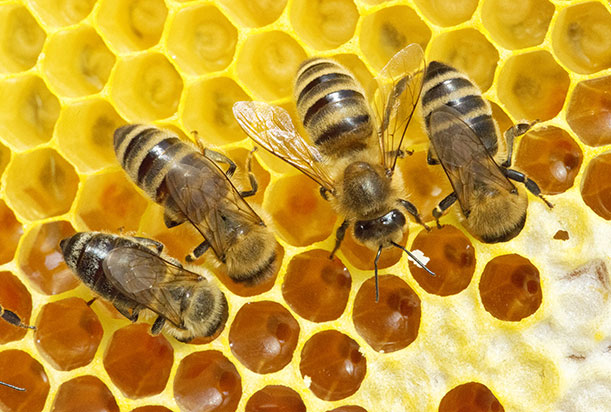BOOMbox at Home: Bees
October 8, 2020

Honey bees help pollinate the food we eat and the flowers we smell. Even though bees are small, they have a large impact on our environment.
Before getting into how they help our environment it's important to know the different types of bees. Honey bees (one of the most recognizable bees) belong to three different groups: the queen, the workers, and the drones. There is only one queen in a hive, and the queen can live up to five years. Worker bees are female and run most of the hive. They help with making and protecting the hive, as well as foraging for food. They are the bees you see outside the hive. Drone bees are the males of the hive and are only around for a couple of months, as their jobs are to mate with the queen.
Pollination Model
Bees are important because they are pollinators. They physically bring pollen to different flowers. When bees land on a flower, some of that flower’s pollen sticks to the bee’s body. When the bee moves to another flower, some of that pollen falls off. You can see how this works using pipe cleaners and a powder such as cheese powder, sugar, flour or another similar ingredient. The pipe cleaners mimic the bee’s bristled legs and the powder mimics pollen. View instructions for this cheese powder pollination activity. Pollinating plants is important because that is how plants become fertilized and produce different foods for us to eat. A few of the foods that are produced through pollination are coffee, apples, potatoes, and melons.
Bee Water Dish
Bees are a crucial part of how we get food, and without them, our environment would be forever changed. In the United States alone, the honey bee population has fallen by half over the past 10 years due to chemicals (such as pesticides), the reduction in land for crops and plants, and disease. One way to help your local bee population, as well as help the environment overall, is to create bee houses or water dishes. Follow our activity sheet to make your own water dish for bees in your neighborhood.
Bee Dance
Living things communicate in different ways--some are easy to break down, and some are not so obvious. Dogs bark or howl, birds chirp, and bees buzz. Bees have a special way of communicating with each other that might not be obvious.
At first glance, it seems that bees communicate just by buzzing. But if you watch bees closely enough, you can see that they convey information through a ‘dance.’ What information do bees need to communicate to each other? An example would be where to find nectar. Bees perform a dance to communicate a location to other bees so they can collect as much nectar as possible.
Want to practice your own dance communication? With some family members, have one person hide sugar packets or something "sugary" without the others seeing. How will you communicate to the other "worker bees" where the sugar is hidden? Create a dance to communicate to your teammates.
Scientist of the Week
Fiona Nelima Mumoki is a bee scientist from Nairobi, Kenya. She was recently awarded a fellowship award from L’Oreal-UNESCO for Women in Science Africa. She is also a PhD candidate at University of Pretoria. Fiona studys communication among bees and how to strengthen the bee population in areas where food is scarce. She cites a strong interest in research from an early age after reading one of her dad’s work books. Fiona is also a strong supporter of women in STEM, and believes that more women visible in STEM will encourage other women to become interested as well.
Written by Erica and Eli.